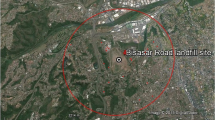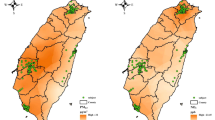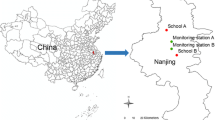Abstract
The World Health Organization has estimated that air pollution is responsible for 1.4 % of all deaths and 0.8 % of disability-adjusted life years. NOIDA, located at the National Capital Region, India, was declared as one of the critically air-polluted areas by the Central Pollution Control Board of the Government of India. Studies on the relationship of reduction in lung functions of residents living in areas with higher concentrations of particulate matter (PM) in ambient air were inconclusive since the subjects of most of the studies are hospital admission cases. Very few studies, including one from India, have shown the relationship of PM concentration and its effects of lung functions in the same location. Hence, a cross-sectional study was undertaken to study the effect of particulate matter concentration in ambient air on the lung functions of residents living in a critically air-polluted area in India. PM concentrations in ambient air (PM1, PM2.5) were monitored at residential locations and identified locations with higher (NOIDA) and lower concentrations (Gurgaon). Lung function tests (FEV1, PEFR) were conducted using a spirometer in 757 residents. Both air monitoring and lung function tests were conducted on the same day. Significant negative linear relationship exists between higher concentrations of PM1 with reduced FEV1 and increased concentrations of PM2.5 with reduced PEFR and FEV1. The study shows that reductions in lung functions (PEFR and FEV1) can be attributed to higher particulate matter concentrations in ambient air. Decline in airflow obstruction in subjects exposed to high PM concentrations can be attributed to the fibrogenic response and associated airway wall remodeling. The study suggests the intervention of policy makers and stake holders to take necessary steps to reduce the emissions of PM concentrations, especially PM1, PM2.5, which can lead to serious respiratory health concerns in residents.




Similar content being viewed by others
References
Adamson, I. Y. R., Vincent, R., & Bjarnason, S. G. (1999). Cell injury and interstitial inflammation in rat lung after inhalation of ozone and urban particulates. American Journal of Respiratory Cell and Molecular Biology, 20, 1067–1072.
Aggarwal, A. N., Gupta, D., & Jindal, S. K. (2007). Comparison of Indian reference equations for spirometry interpretation. Respirology, 12(5), 763–768.
Bates, C. V., & Sizto, R. (1987). Air pollution and hospital admissions in Southern Ontario: the acid summer haze effect. Environmental Research, 43, 317–331.
Bellendi, V., Fanstini, A., Statoggia, M., Cattani, G., Marconi, A., Perucci, C. A., & Forastiere, F. (2010). Impact of fine and ultrafine particles on emergency hospital admissions for cardiac and respiratory diseases. Epidemiology, 21(3), 414–423.
Brunckreef, B. (2003). Design of cohort studies for air pollution effects. Journal of Toxicology and Environmental Health. Part A, 66, 1723–1734.
Cakmak, S., Burnett, R. T., Jerrett, M., Goldberg, M. S., Pope, A., Ma, R., Gultekin, T., Thun, M. J., & Krewski, D. (2003). Spatial regression models for large cohort studies linking community air pollution and health. Journal of Toxicology and Environmental Health. Part A, 66, 1811–1824.
Chang, L. T., Koutrakis, P., Catalano, P. J., & Suh, H. H. (2003). Assessing the importance of different exposure metrices and time activity data to predict 24 h personal PM2.5 exposures. Journal of Toxicology and Environmental Health. Part A, 66, 1825–1846.
Churg, A., Brauer, M., Casado, M. C. A., Fortail, T. I., & Wright, J. L. (2003). Chronic exposure to high levels of particulate air pollution and small airway remodelling. Environmental Health perspectives, 111, 714–718.
Churg, A., Brauer, M., & Keeling, B. (1996). Ozone enhances the uptake of mineral particles by tracheobronchial epithelial cells in organ culture. American Journal of Respiratory and Critical Care Medicine, 153, 1230–1234.
Churg, A., Brauer, M., Vedal, S., & Stevens, B. (1999). Ambient mineral particles in the small airways of the normal human lung. Journal of Environmental Medicine, 1, 39–46.
Cohen, A. J., Krewski, D., Samet, J., & Willes, R. (2003). Health and air quality: interpreting science for decision makers. Journal of Toxicology and Environmental Health. Part A, 66, 1489–1903.
CPCB. (2009) Comprehensive environmental assessment of industrial clusters. Central Pollution Control Board, Ministry of environment and forests. New Delhi, Ecological Impact Assessment Series: EIAS/5/2009-10.
Dai, J., Xie, C., & Churg, A. (2002). Iron loading makes a non-fibrogenic model air pollutant particle fibrogenic in rat tracheal explants. American Journal of Respiratory Cell and Molecular Biology, 26, 685–693.
Dockery, D. W., & Pope, C. A. (1994). Acute respiratory effects of particulate air pollution. Annual Review of Public Health, 15, 107–132.
Dominguez, R. A., Abren, A. J., Rodriguez, S., Juavez-prera, R. A., Arroya-Ucar, E., Jimenez, S. A., Gonzalez, Y., Abreu, G. P., & Avanzas, P. (2011). Comparative study of ambient air particles in patients hospitalized for heart failure and acute coronary syndrome. Revista Española de Cardiología, 64(8), 661–666.
EPA (Environmental Protection Agency) (1996). Air quality criteria for particulate matter. Washington, DC, USA. Environmental Protection Agency, EPA/600/P-95/001 cF.
Greenbaum, D. S. (2003). A historical perspective on the regulation of particles. Journal of Toxicology and Environmental Health. Part A, 66, 1493–1498.
Kesavachandran, C. N., Bihari, V., Pangtey, B. S., Pathak, M. K., Fareed, M., Mathur, N., & Srivastava, A. K. (2011). Respiratory health problems associated to infrastructure development among residents living near Special Economic Zone in India. Clean Technologies and Environmental Policy, 13, 697–702. doi:10.1007/s10098-010-0337-x.
Maestrelli, P., Canova, C., Scapellato, M. L., Visentin, A., Tessari, R., Bartolucci, G. B., Simonato, L., & Lotti, M. (2011). Personal exposure to particulate matter is associated with worse health perception in adult asthma. Journal of Investigational Allergology and Clinical Immunology, 21(2), 120–128.
Maynard, R., Krewski, D., Burnett, R. T., Samet, J., Brook, J. E., Granville, G., & Craig, L. (2003). Health and air quality: directions for policy-relevant research. Journal of Toxicology and Environmental Health. Part A, 66, 1499–1501.
Moolgavkar, S. H., Luebeck, E. G., & Anderson, E. L. (1997). Air pollution and hospital admissions for respiratory causes in Minneapolis- St. Paul and Birmingham. Epidemiology, 8, 364–370.
Nascimento, L. F. (2011). Air pollution and cardiovascular hospital admissions in a medium sized city in Sao Paulo state, Brazil. Brazilian Journal of Medical and Biological Research, 44(7), 720–724.
Pinkerton, K. E., Green, F., Saki, C., Vallyathan, V., Plopper, C. G., Gopal, V., et al. (2000). Distribution of particulate matter and tissue remodeling in the human lung. Environmental Health Perspectives, 108, 1063–1069.
Pope, C. A. (2000). Epidemiology of fine particulate air pollution and human health: biologic mechanism and who’s at risk? Environmental Health Perspectives, 108, 713–723.
Raizene, M. (2003). Science and regulation—US and Canadian overview. Journal of Toxicology and Environmental Health. Part A, 66, 1503–1506.
Rastogi, S. K., Mathur, N., Kesavachandran, C., & Agarwal, G. G. (2007). Prediction models for peak expiratory flow rates in North Indian male population: models based on ordinary and weighted least square estimations. Current Science, 93(7), 959–963.
Samet, J., & Krewski, D. (2007). Health effects associated with exposure to ambient air pollution. Journal of Toxicology and Environmental Health. Part A, 40, 227–242.
Scapellato, M. L., & Lotti, M. (2007). Short-term effects of particulate matter: an inflammatory mechanism? Critical Reviews in Toxicology, 37, 461–487.
Sharma, S., Kumar, V. N., Katiyar, S. K., Sharma, R., Shukla, B. P., & Sengupta, B. (2004). Effects of particulate air pollution on respiratory health of subjects who live in three areas in Kanpur, India. Archives of Environmental Health, 59, 348–358.
White, W. H., & Suh, H. H. (2003). Monitoring exposure to ambient air pollutants. Journal of Toxicology and Environmental Health. Part A, 66, 1879–1882.
WHO. (2002). World health report. Geneva: World Health Organization.
Workshop Report (2006). Global initiative for asthma—updated. Retrieved from http://www.ginasthma.com. Accessed 6 July 2011.
Xu, X. P., Dockery, D. W., & Wang, L. H. (1991). Effects of air pollution on adult pulmonary function. Archives of Environmental Health, 46(4), 198–206.
Acknowledgments
The authors thank Mr. NK Yadav, Project Assistant, for the data compilation. This work was funded by the Council of Scientific and Industrial Research (CSIR), Government of India, under Network project NWP 17. This is IITR Comm. no. 2897.
Author information
Authors and Affiliations
Corresponding author
Rights and permissions
About this article
Cite this article
Kesavachandran, C., Pangtey, B.S., Bihari, V. et al. Particulate matter concentration in ambient air and its effects on lung functions among residents in the National Capital Region, India. Environ Monit Assess 185, 1265–1272 (2013). https://doi.org/10.1007/s10661-012-2630-0
Received:
Accepted:
Published:
Issue Date:
DOI: https://doi.org/10.1007/s10661-012-2630-0




